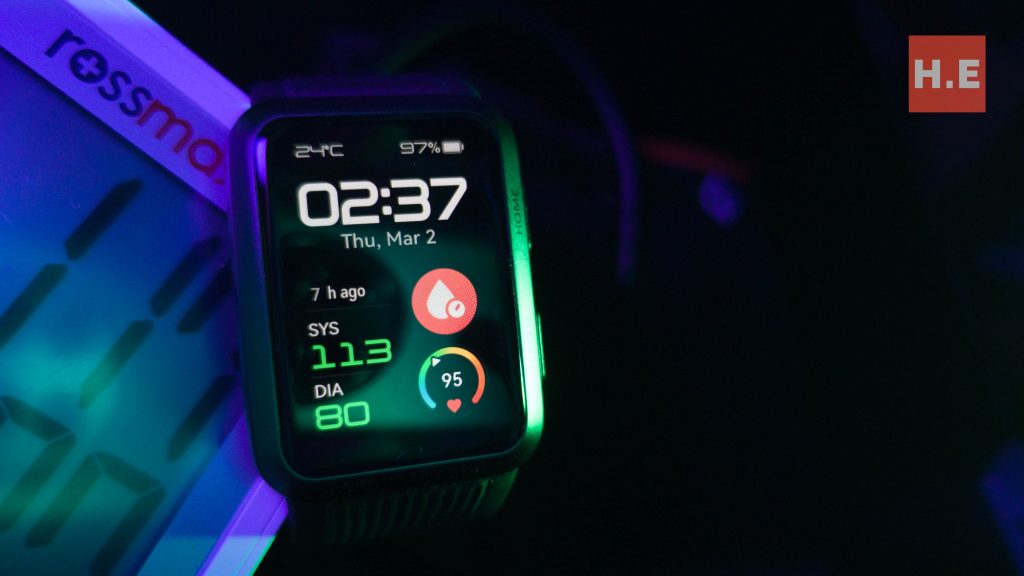As our earlier article mentioned, one of the key features, if not the most prominent, of the Huawei Watch D is its ability to measure blood pressure. However, is the Huawei Watch D really accurate when compared to more common blood pressure measuring devices? In this article, we will explore is the Huawei Watch D accurate, we will compare Huawei Watch D’s accuratecy when compared to other devices.
Huawei Watch D Technology Overview

Before delving into the accuracy of the Huawei Watch D, it is essential to understand what blood pressure is and how it is measured. Blood pressure is the force exerted by the blood against the walls of the arteries as it flows through them. It is measured in millimetres of mercury (mmHg) and is made up of two readings: the pressure when the heart contracts (systolic pressure) and the pressure when the heart relaxes (diastolic pressure). Another reading that is added in to help make sense of blood pressure is the beats per minute (bpm), which, as the name suggests, indicate the amount of heart beats per minute.
Traditionally, blood pressure is measured using a sphygmomanometer, which involves inflating a cuff around the upper arm and listening to the sound of the blood flow as it is released. However, with the advancement of technology, smartwatches like the Huawei Watch D have integrated sensors that can measure blood pressure accurately.
The Huawei Watch D uses a photoplethysmography (PPG) sensor to measure blood pressure. The PPG sensor works by emitting light into the skin, which is absorbed by the blood vessels. The reflected light is then detected by the sensor, which generates a waveform that corresponds to the pulsations of the blood vessels. Below the wrist band there the cuff that to be inflate to enable the sensor to precisely measure user’s blood pressure.
How we test
We follow the best practises established by the American Heart Association to ensure that we get the most accurate result possible:
- Be still. Don’t smoke, drink caffeinated beverages, or exercise within 30 minutes of measuring blood pressure.
- Emptied my bladder and ensure at least 5 minutes of quiet rest before measurements.
- Sit correctly. Sit with back straight and supported (on a dining chair rather than a sofa).
- Feet should be flat on the floor, and legs should not be crossed. Your arm should be supported on a flat surface (such as a table), with the upper arm at heart level. Make sure the bottom of the cuff is placed directly above the bend of the elbow.
- Not taking measurements over clothes.
We also gave at least one minute’s interval or until my heartbeat reached less than 100.
Below is our recording comparing the Huawei Watch D with a blood pressure monitor, the Rossmax Z1.
Check 1
| Huawei Watch D | Rossmax Blood Pressure Monitor Z1 | |
| Sys/mmHg | 128 | 122 |
| DIA/mmHg | 83 | 85 |
| Pulse/Min | 103 | 98 |
Check 2
| Huawei Watch D | Rossmax Blood Pressure Monitor Z1 | |
| Sys/mmHg | 120 | 120 |
| DIA/mmHg | 81 | 85 |
| Pulse/Min | 102 | 95 |
Check 3
| Huawei Watch D | Rossmax Blood Pressure Monitor Z1 | |
| Sys/mmHg | 113 | 114 |
| DIA/mmHg | 80 | 74 |
| Pulse/Min | 105 | 103 |
So, is the Huawei Watch D accurate?
According to our recording, while the reading is not fully aligned between the Huawei Watch D and the Rossmax Z1, it is still within the ballpark figure. We might be able to draw a conclusion from this, but we are not quite satisfied with it.
Spending more time on the subject, we came across a journal from Wolters Kluwer Health, an information provider for various fields, where a group of researchers worked on verifying the accuracy of the Huawei Watch D. The journal title “Validation of the watch-type HUAWEI WATCH D oscillometric wrist blood pressure monitor in adult Chinese“, has run the watch through the AMI/ESH/ISO Universal Standard testing method and tested the watch with 85 people. Their conclusion is that “The HUAWEI WATCH D watch-type wrist BP monitor fulfilled all the requirements of the AAMI/ESH/ISO Universal Standard in the general population and can be recommended for self-measurement.“
So long story short, yes, the Huawei Watch D’s blood pressure reading is accurate, as confirmed by research done by professional bodies and indicated in our test as well. The watch can serve as an excellent tool for monitoring blood pressure on the go, giving the user a clearer view of their blood pressure and health. But as a reminder, the Huawei Watch D is not a replacement for traditional blood pressure measurements taken by a healthcare professional. If you have concerns about your blood pressure, it is always best to consult your doctor or a healthcare professional.
Help us!
So here you go, our review on testing is the Huawei Watch D accurate. If you agree with us and want to pick one up, do consider purchasing via the link below. The affiliate link doesn’t cost you any extra, but will be a great help to keep our lights on here at HelloExpress.
Lazada: https://s.lazada.com.my/s.UiJBc